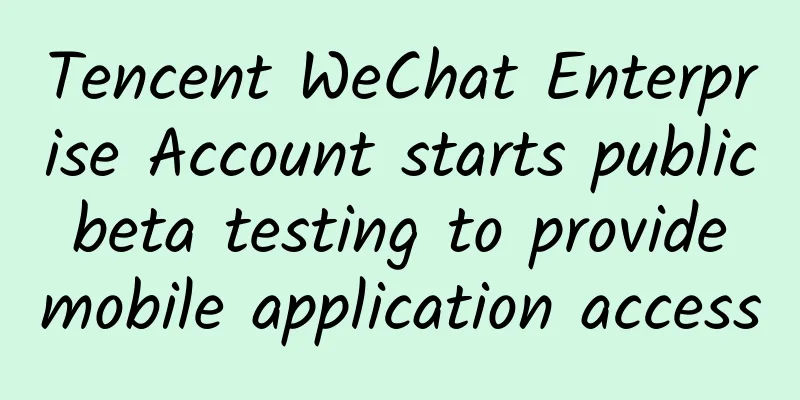Alipay Mini Program is here! This may be Alibaba’s most important strategy after Jack Ma announced his resignation!

|
There is a saying in the Internet industry: in the future, platforms will swallow the world. Internet companies such as Tencent, Alibaba, and JD.com have all opened up their mature infrastructure and capabilities to empower developers and build a platform that can efficiently and multi-dimensionally serve users. In the future, users will only need to use a few platforms to meet most of their needs. Tencent took the lead with WeChat Mini Programs. After more than a year of launch, it has attracted more than 1 million developers and 300 million daily active users, successfully establishing a mature platform ecosystem. Compared with the rapid development of WeChat Mini Programs, the Alipay Mini Programs belonging to Alibaba seem to be moving forward at a leisurely pace. On September 20, 2017, the Alipay Mini Program was officially launched for public testing for C-end users. One year later (September 12), Ant Financial announced that the Alipay Mini Program had ended public testing and was officially launched. Guan Zhong, the person in charge of the Alipay Mini Program, said that the Mini Program will be one of Alipay's key strategies for the next three years. Before Alipay was officially launched, Xiaochengjucha had a nearly two-hour discussion with Guan Zhong, asking why the company took a year to launch the mini-programs? What exactly does the mini-program that represents Alipay's strategy for the next three years look like? What are the differences between the mini-programs and WeChat mini-programs? ... These questions all had clear answers. One year after the public beta Alipay Mini Programs’ ambitions begin to emerge At the Ant Open Day Mini Program session today, He Yongming (nickname Guan Zhong), the person in charge of the Alipay Mini Program, announced the achievements of the Alipay Mini Program in the past year: The number of mini programs has reached more than 20,000, with a cumulative DAU of more than 120 million, more than 300 million cumulative users, more than 1 million partners, and more than 100,000 active service providers. The average 7-day retention rate of mini programs is 29%, and the average transaction conversion rate of multiple categories exceeds 15%. It can be seen that the basic prototype of an ecosystem has been formed. In order to push the achievement to a higher level, Alipay also announced the establishment of the Mini Program Division, bringing "three great gifts" to developers and merchants: Open the payment success page entrance to open a complete closed loop from service, new customer acquisition to retention and activation; Fully connect to the Alibaba ecosystem to achieve one-time development and multi-terminal operation; A 1 billion innovation fund has been invested in three years to help developers and businesses upgrade various service scenarios. Currently, nine major categories have been opened, including tools, retail, life services, travel and transportation, charity, finance, education, medical care, and government affairs. More importantly, in terms of the way of entry, you can choose from three methods: "independent development", "template development" and "customized development". Physical stores only need to pay as low as 9.9 yuan and can even have their own Alipay mini program for free. A series of measures seem to indicate that the Alipay Mini Program will be fully launched in the future, which is very different from the previous slow pace of development. One year of public beta What does the Alipay Mini Program do? In fact, compared with WeChat Mini Programs, Alipay Mini Programs are a "latecomer". What puzzles many people is that it took a whole year for Alipay Mini Programs to be launched publicly, so much so that some people commented that Alipay's pace was too slow. What exactly has the Alipay Mini Program been doing this year? According to Guan Zhong, Alipay Mini Programs have been exploring two main aspects this year: Strengthen the basic technology of mini programs Seeking self-positioning and platform differentiation It may seem simple on the surface, but it is not easy. Take “seeking platform differentiation” as an example. The “differentiation” here mainly refers to the differentiation from WeChat. First of all, we must see that the attributes of the two major ecosystems, Alipay and WeChat, are not the same. The WeChat ecosystem is centered on social interaction and is gradually moving towards information, content, and marketing. The most praised feature of WeChat mini-programs is their strong fission property based on social relationships. Alipay's ecosystem is centered on business. The larger the scale, the more important risk management is, so it has always maintained a cautious attitude towards opening up. "Alipay has a total of 700 million active users, almost all of whom are commercial users. This huge user value is borne by us. For example, once a micro-business has a problem, the first person responsible may not be WeChat, but if there is a problem with Alipay, the first person responsible will definitely come to you. Users come because they trust you. This kind of commercial respect needs our protection. Our openness means that we have to open these users to the entire ecosystem." Guan Zhong said. Therefore, over the past year or so, Alipay Mini Programs has been attracting developers and introducing more partners through public beta testing. On the one hand, this allows time to consolidate the infrastructure, and on the other hand, it allows them to explore more gameplay and directions through partners. In Guan Zhong's view, it is precisely because of this difference in ecological attributes that Alipay Mini Programs must take its own development path, although there is still some resistance at present. Because for most users, Alipay is just a payment tool, and it is difficult to think of Alipay in other scenarios. This cognition hinders its vision of building a platform. The key to breaking the deadlock lies in the mini program. Alipay starts from the payment link and uses the mini program to extend the commercial value of Alipay, making it a "one-stop toolbox" in finance, commerce, life services, etc., thereby changing user perception. "Looking back at the development history of Alipay, it is naturally a tool and a service. Even though it later became a platform, it is still a tool platform and a service platform," Guan Zhong told us. Therefore, after more than a year of exploration, Alipay has finally defined the development direction of mini programs - focusing on "money, business, and services", leveraging the advantages of Alipay and Alibaba Group, and making comprehensive efforts in the three major areas of new finance, new retail, and new services. How to play with new finance, new retail, Three new service areas? As we all know, Alipay has very strong financial advantages, tool attributes and service mentality, and the Alipay mini program will start from these three most high-quality areas of Alipay. New finance is the cornerstone of Alipay mini-programs In fact, Alipay is the app closest to money, services, and trust. Trust is the cornerstone of Alipay. Guan Zhong said: "We have established service, credit and business systems since 2007, and have been opening up some capabilities, such as credit capabilities, payment capabilities, and possibly security capabilities in the future." Among these capabilities, credit has always been the core competitiveness of Alipay. In fact, when Alipay's mini program was publicly tested, Sesame Credit played an important role in both OFO and charging pile cases. For example, when a user is in a public place and urgently needs to charge his phone, if he rents an offline mobile charger through other channels, he may have to pay a certain amount of deposit. However, if you search for "rental" on Alipay, you can see a variety of related mini-programs. On the "Zhima Credit" page, the main feature "no deposit" is also mainly displayed with various rental mini-program products. Users can use Sesame Credit to rent mobile chargers without a deposit. It is understood that Jiedian launched the Alipay mini program in August 2017. After introducing open capabilities such as credit borrowing and repayment, Jiedian's Alipay order volume increased by 6 times, the access pass rate increased by 7.6%, and the overall bad debt rate decreased by 50%. In the past year since entering the Alipay mini program, it has accumulated more than 50 million users. At present, the total number of merchants and enterprises that have been granted credit has reached 17 million, and the number of merchants and enterprises that have completed withdrawals has reached millions, providing small and micro enterprises with convenient capital turnover credit services. In the future, merchants and individuals who provide transaction scenario services through Alipay mini programs can continue to accumulate their Sesame Credit, increase their credit limits, expand their scale or develop more businesses. Therefore, it is not difficult to understand why Alipay puts new finance in an important position. This positioning has inherent advantages. Whether it is consumer finance, wealth management business, corporate and personal credit business, or insurance business, Ant Financial has achieved rapid growth. Its powerful technology has formed a variety of financial scenarios, which helps to shape an efficient and intelligent financial risk control system, the Alipay applet. Mini Programs are jointly explored by Alibaba and Ant The nuclear weapon of new retail Let’s look at new retail. In fact, since the public beta of the Alipay Mini Program was announced, the industry has been discussing how it will do e-commerce. After all, not long ago, the Alipay homepage opened up a Feng Shui treasure land for the group buying mini program. Guan Zhong was also asked this question many times, but he made it clear that “During the public beta stage, the e-commerce and new retail fields are more Ali’s internal brands, because it is easier to connect and test. But there is no doubt that we will definitely open up the new retail that everyone is paying attention to and needs.” This decision is very reasonable. After all, Alibaba's strong e-commerce genes do not need to be enhanced by mini programs. However, the big topic of new retail in the next four years (first mentioned by Jack Ma in 2017) requires multi-faceted efforts and exploration from Alibaba and Ant Group. The results of this year's public beta test have proven that mini programs are a booster for new retail. The seven major entrances proposed at this conference explained the outlook of Alipay mini programs for new retail. The 7 major entrances refer to scan, search, friends tab main entrance, payment success page, mini program collection, life account and card wallet. Among them, Guan Zhong particularly pointed out that the "payment success page" is a particularly important entrance. Since most merchants care most about repeat purchases, the payment success page is the beginning of repeat purchases after payment. This entrance can help developers cultivate a new "payment is relationship" user habit for mini-programs and solve the retention problem of mini-programs that are used and left. Taking offline stores as an example, after the customer completes the transaction, the store can directly display its own mini program on the payment success page, and guide users to pay attention to the collection by sending coupons when following the customer. In the subsequent daily operations, it can use life account message reach, card package and coupon secondary marketing and other channels to stimulate customers to repurchase. According to the Alipay team's idea, these seven entrances will form a complete closed loop from service, attracting new customers, retention to activation. WeChat mini programs emphasize connecting online and offline because the online traffic dividend has basically bottomed out and offline traffic has become a hot commodity. The combination of the two can produce a chemical reaction of 1+1>10. Alipay, which has been deeply involved in offline payments, is certainly well aware of this. At present, mini programs have become the nuclear weapon of connection. The most frequent service applications It is the "background color" of Alipay Mini Program In the communication with Guan Zhong, service was repeatedly emphasized: "Because Alipay and Alipay Mini Programs provide services, and they provide services from a business perspective, which is also the underlying color of Alipay Mini Programs." How to use mini programs to realize the new services mentioned by Guan Zhong? One case can illustrate: In the past, people had to go to the site to use self-service equipment or manually fill out forms, take photos, and pay fees to apply for entry and exit documents. People had to wait in line at each stage. During peak hours, it usually took more than 3 hours for people to apply for entry and exit documents; there was no way to check the progress of the application and the validity period reminder in the later period. Wuhan launched the Alipay applet, introduced Alipay facial recognition, online payment, and document card package capabilities, and shortened the entry and exit business to less than 30 minutes. So far, the number of users has exceeded 100,000, and the amount of fees has exceeded 60 million. The development cost of such a mini program is extremely low. Guan Zhong revealed that Alipay has worked with third-party platforms to develop a series of mini program templates, including catering, retail, scenic spots, service reservations, hospital medical care, aftermarket, and urban services, greatly lowering the threshold for entrepreneurs and merchants to open Alipay mini programs. Stores only need to select components and upload information, and the minimum cost is 9.9 yuan. The whole process is simpler than opening a Taobao store. The new service is also a great help in connecting online and offline: for example, placing Alipay Mini Program QR codes in offline stores to guide users to scan and pay directly. In addition, it can also promote "cross-industry cooperation", such as placing "Bank Alipay Mini Program QR Code" and "Water Company Mini Program QR Code" in supermarkets to guide users to scan and pay directly when queuing for checkout, achieving the effect of "killing two birds with one stone". It can be seen that although Alipay emphasizes its differentiation from WeChat, there is one point on which the two agree: both are integrating the group's internal resources and fully empowering merchants through mini-programs. For example, WeChat provides mini-programs with capabilities such as Tencent Cloud and WeChat Pay, and the Alipay mini-programs can also be connected to Fengniao Delivery, etc. I believe that 2018 will be the year of explosion for mini programs, as both AT giants have entered the market, and they both have very mature ideas. |
<<: Just read one article. All the new products of Apple's autumn conference are here.
>>: Where will WeChat go in the second half?
Recommend
How to use the pyramid model to implement user stratification operations (with case studies)
As the Internet becomes more and more permeable i...
How is Pinduoduo’s crisis public relations?
Yesterday afternoon, Pinduoduo held an emergency ...
Get 10,000+ users in 7 days, with a conversion rate of over 50%. You only need to do 3 things to achieve group fission
% ignore_pre_1 % When talking about traffic now, t...
Uncovering the gray industry chain of short-lived mobile games that suck money like crazy
[[129846]] With the development of mobile Interne...
WeChat circle application template, how to write the reason for applying for WeChat circle?
WeChat Circles is a new product launched by WeCha...
When will the Qingdao epidemic end in 2022? When will it be unblocked? Attached the latest news
Recently, the first city in Shandong Province to ...
The first set of photography system courses for clothing people, a compulsory course for mobile clothing photography, just look at Brother Chao to learn clothing photography
The first set of photography system courses for c...
iOS 16.4 Quick Security Response Update
Today, Apple released a quick security response u...
Android uses JobScheduler to perform background tasks
JobScheduler Introduction JobScheduler is used in...
520 confession posture, programmers all do this...
Counting with fingers Today is 520 Love Confessio...
Come, let’s explain in simple terms what CPA and OCPC are.
Ever since Toutiao launched the CPA and OCPC mode...
Analyst Benedict Evans: What changes will happen to the mobile ecosystem in the future
Editor's note: The development of smartphones...
In-depth analysis: How many years will the popular internet celebrity brands remain popular?
The word "Internet celebrity" has been ...
First Prize for Primary School Student's Cancer Research Paper Revoked (Attached with Full Notice)
First prize for primary school student's canc...
APP promotion and operation: a complete analysis of the user growth system!
The user growth system is a mechanism that record...









